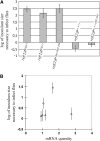Control of sigma virus multiplication by the ref(2)P gene of Drosophila melanogaster: an in vivo study of the PB1 domain of Ref(2)P
- PMID: 17409092
- PMCID: PMC1893033
- DOI: 10.1534/genetics.106.063826
Control of sigma virus multiplication by the ref(2)P gene of Drosophila melanogaster: an in vivo study of the PB1 domain of Ref(2)P
Abstract
Ref(2)P has been described as one of the Drosophila proteins that interacts with the sigma virus cycle. We generated alleles to identify critical residues involved in the restrictive (inhibiting viral multiplication) or permissive (allowing viral multiplication) character of Ref(2)P. We demonstrate that permissive alleles increase the ability of the sigma virus to infect Drosophila when compared to null alleles and we confirm that restrictive alleles decrease this capacity. Moreover, we have created alleles unfunctional in viral cycling while functional for Ref(2)P fly functions. This type of allele had never been observed before and shows that fly- and virus-related activities of Ref(2)P are separable. The viral status of Ref(2)P variants is determined by the amino-terminal PB1 domain polymorphism. In addition, an isolated PB1 domain mimics virus-related functions even if it is similar to a loss of function toward fly-related activities. The evolutionary tree of the Ref(2)P PB1 domain that we could build on the basis of the natural allele sequences is in agreement with an evolution of PB1 domain due to successive transient selection waves.
Figures





Similar articles
-
Localization of domains within the Drosophila Ref(2)P protein involved in the intracellular control of sigma rhabdovirus multiplication.J Virol. 1995 Jul;69(7):4463-70. doi: 10.1128/JVI.69.7.4463-4470.1995. J Virol. 1995. PMID: 7769706 Free PMC article.
-
Unusual variability of the Drosophila melanogaster ref(2)P protein which controls the multiplication of sigma rhabdovirus.Genetics. 1993 Apr;133(4):943-54. doi: 10.1093/genetics/133.4.943. Genetics. 1993. PMID: 8462852 Free PMC article.
-
Study of the ref(2)P locus of Drosophila melanogaster. II. Genetic studies of the 37DF region.Mol Gen Genet. 1993 Jun;239(3):361-70. doi: 10.1007/BF00276934. Mol Gen Genet. 1993. PMID: 8316210
-
The age and evolution of an antiviral resistance mutation in Drosophila melanogaster.Proc Biol Sci. 2007 Aug 22;274(1621):2027-34. doi: 10.1098/rspb.2007.0611. Proc Biol Sci. 2007. PMID: 17550883 Free PMC article.
-
Tracking adaptive evolutionary events in genomic sequences.Genome Biol. 2002;3(6):REVIEWS1018. doi: 10.1186/gb-2002-3-6-reviews1018. Epub 2002 May 29. Genome Biol. 2002. PMID: 12093382 Free PMC article. Review.
Cited by
-
Drosophila as a model for antiviral immunity.World J Biol Chem. 2010 May 26;1(5):151-9. doi: 10.4331/wjbc.v1.i5.151. World J Biol Chem. 2010. PMID: 21541000 Free PMC article.
-
Vertically transmitted viral endosymbionts of insects: do sigma viruses walk alone?Proc Biol Sci. 2012 Oct 7;279(1744):3889-98. doi: 10.1098/rspb.2012.1208. Epub 2012 Aug 1. Proc Biol Sci. 2012. PMID: 22859592 Free PMC article.
-
The Deubiquitinating Enzyme UBPY Is Required for Lysosomal Biogenesis and Productive Autophagy in Drosophila.PLoS One. 2015 Nov 16;10(11):e0143078. doi: 10.1371/journal.pone.0143078. eCollection 2015. PLoS One. 2015. PMID: 26571504 Free PMC article.
-
Innate and intrinsic antiviral immunity in Drosophila.Cell Mol Life Sci. 2017 Jun;74(11):2039-2054. doi: 10.1007/s00018-017-2453-9. Epub 2017 Jan 19. Cell Mol Life Sci. 2017. PMID: 28102430 Free PMC article. Review.
-
The selectivity and specificity of autophagy in Drosophila.Cells. 2012 Jun 29;1(3):248-62. doi: 10.3390/cells1030248. Cells. 2012. PMID: 24710475 Free PMC article.
References
-
- Ayala, F. J., and C. A. Campbell, 1974. Frequency-dependent selection. Annu. Rev. Ecol. Syst. 5: 115–138.
-
- Bichon, A., N. Boukhatem, P. Gay, P. Dru, H. Terzian et al., 2001. Genetic and molecular features of Su(P), a gene that interacts with ref(2)P in male fertility of Drosophila melanogaster. Mol. Genet. Genomics 265: 354–361. - PubMed
-
- Brun, G., and N. Plus, 1980. The viruses of Drosophila, pp. 625–702 in The Genetics and Biology of Drosophila, edited by M. Ashburner and T. R. F. Wright. Academic Press, London.
-
- Bussereau, F., 1970. Study of CO2 sensitivity symptom induced by sigma virus in Drosophila. I. Influence of inoculation place on delay of symptom appearance. Ann. Inst. Pasteur (Paris) 118: 367–385. - PubMed
Publication types
MeSH terms
Substances
LinkOut - more resources
Full Text Sources
Molecular Biology Databases
Miscellaneous

